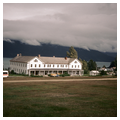You are here
Fort William H. Seward
Fort Seward was the last of eleven military posts built in Alaska between 1897 and 1904 in response to the intense activity surrounding the gold rush. Located at Haines because of its proximity to the three major paths to the Klondike, the post was staffed with two companies previously located at Skagway. Never fortified, the post was renamed Chilkoot Barracks in 1922 and remained the only active military post in Alaska until 1940. After World War II, Chilkoot Barracks was declared surplus and sold to private owners. Arranged around a rectangular parade ground, the post's setting on the side of a small hill contributes to the impact of the neatly arranged buildings.
Aside from those mentioned below, other buildings at the fort included the hospital and administrative offices on one side of the parade ground and a guardhouse and quarters on the other. Toward the water were more functional buildings, such as the stable, cook house, and blacksmith shop. Off to one side was housing for noncommissioned officers and civilians. Most of these secondary buildings survive.
Although somewhat plain in design, the number of these buildings and their strict alignment make an undeniable impact. The granite ashlar used in foundations, clapboards covering wood-framed walls, and brick in the chimneys are materials common to military buildings of this period but unusual in Alaska. The post remains virtually intact, with only the loss of the barrack and the stables detracting from a fine collection of early twentieth-century buildings. Private owners have converted several buildings into a hotel and bed-and-breakfasts, and the Tlingit plank house and trapper's cabin (SE011.3) serve as tourist attractions. Most jarring about these reconstructions, however, is their placement in the parade ground, a planned open space. Detached from their proper surroundings, they detract considerably from the grandeur of the military post. Yet the regularity of the plan and the size of the quarters—far larger than most residential buildings in Southeast—are not lost and still stand as a firm declaration of a military presence.
Writing Credits
If SAH Archipedia has been useful to you, please consider supporting it.
SAH Archipedia tells the story of the United States through its buildings, landscapes, and cities. This freely available resource empowers the public with authoritative knowledge that deepens their understanding and appreciation of the built environment. But the Society of Architectural Historians, which created SAH Archipedia with University of Virginia Press, needs your support to maintain the high-caliber research, writing, photography, cartography, editing, design, and programming that make SAH Archipedia a trusted online resource available to all who value the history of place, heritage tourism, and learning.




